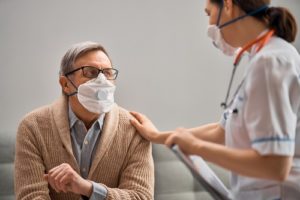Beyond the Mask: How Caregivers Can Still Make Personal Connections

Ben Ashton, Director, Good Oaks Home Care
Personal protective equipment (PPE) like masks, surgical gowns, and face shields have become essential elements in helping to prevent the spread of COVID-19.
But for senior care facility residents, interacting with caregivers, doctors, and specialists wearing PPE, particularly masks, can be an alienating experience. However, healthcare professionals can still maintain personal connections with residents by taking some additional steps when wearing PPE.
Use Empathy and Compassion
Dr. Herman Williams, MD, MBA, and Managing Director within the BDO Center for Healthcare Excellence & Innovation, notes that empathy and compassion are essential to humanizing caregiving when wearing PPE. “All best practices try and use empathy and compassion in these scenarios,” explains Dr. Williams.
“Understanding that patients cannot see expressions will require practitioners and caregivers to provide more explanations when communicating with residents. PPE is impersonal and can make residents feel “unclean” or “infectious,” so practitioners need to explain why it is necessary for their health and safety.
“For example, you might say to the client, “This equipment is to prevent me from infecting you, as well as protecting me from any illnesses you have,” or, “This is very impersonal, but we now know viruses can be passed through hands, and people put their hands in their mouth and eyes which can cause infection. Therefore, we will no longer be shaking hands. Instead, we will bump elbows when we see each other,” recommends Dr. Williams.
Ben Ashton, Director of Good Oaks Home Care, notes that caregivers can still provide reassurance and a friendly demeanor, even when wearing PPE. “Asking, “Can you hear me ok?” is an important one, as caregivers’ voices might be muffled by the mask and some of our clients have difficulty hearing,” notes Ashton.
“Then, making friendly conversation as usual, showing concern for individuals, and asking them how they are doing. Thinking about keeping body language open and relaxed and being sure to make eye contact with clients can also really help.”
Find Strategies to Show Your Face
Finding ways to show your face can also help to make a personal connection with residents. Dr. Williams recommends that facilities position masks outside of patient rooms. Before caregivers put their masks on, they can stand at the room’s entrance, show their faces and introduce themselves with a smile before putting on the mask and entering the room.
Ashton explains that all Good Oaks Home Care caregivers wear photo ID badges that clearly display their names and photos. “This reminds our clients of their names and also shows what they look like without the mask,” says Ashton.
Senior care facilities aren’t the only locations working to help patients and residents see healthcare professionals’ faces. At Stanford Medicine’s drive-through COVID-19 testing sites, nurses and physician assistants wear disposable headshots created with a smartphone, a printer, and adhesive labels. These portraits help to create a connection between healthcare professional and patient, and the same strategy could be used in senior care facilities.
Show Your Personality
Ashton has also focused heavily on how caregivers can still allow their friendly, caring attitudes to shine through during the pandemic. “Good Oaks usually offers a driving service, which enables our clients to make social visits.
“As this isn’t possible at the moment, our carers have been assisting clients with Zoom calls to clients stay in touch with their families and friends. This has been a real lifeline. Being able to see their loved ones at a time when they aren’t able to visit just makes their day. Our carers represent a vital link to the world outside,” explains Ashton.
“In a similar way, one of our Live-In carers set up a WhatsApp group for the family of one of our clients. Our client has been sending photos and voice notes to family, who reply – delighted to have heard from her while they aren’t able to visit. Thinking of new ways to stay in touch with loved ones has been essential to home care during the pandemic.”
Ashton also notes that the Good Oaks offices help to organize shopping deliveries as necessary, and also provide clients with a catch-up phone call service they can use if they’re feeling lonely. These efforts can help to personalize caregivers and allow them to engage with clients in multiple ways.
Focus on Humanizing Caregiving
Dr. Williams recommends that facilities take multiple steps in humanizing caregiving during the COVID-19 pandemic:
- Be lenient about the number of visitors allowed for patients with severe illnesses.
- Require all visitors to wear N95 or KN95 masks.
- Take extra time when explaining procedures so residents understand why precautions are being taken.
- Be deliberate in showing cleanliness precautions, like putting on a new mask so that a resident can see when you enter a room, or washing your hands when you enter and leave in front of the resident.
- Spend more time listening during these stressful times and always ask, “Is there anything else I can do?” before leaving.
The pandemic has required senior care facilities to evolve and be creative in finding new ways to deliver quality care to residents. Finding strategies to personalize that care can help to put residents at ease and make for a better caregiver-resident connection.

Paige Cerulli is a contributing writer to i Advance Senior Care.
Related Articles
Topics: Departments , Featured Articles , Infection control , Resident Care










